belt Acura TSX 2004 Owner's Guide
[x] Cancel search | Manufacturer: ACURA, Model Year: 2004, Model line: TSX, Model: Acura TSX 2004Pages: 364, PDF Size: 5.35 MB
Page 27 of 364
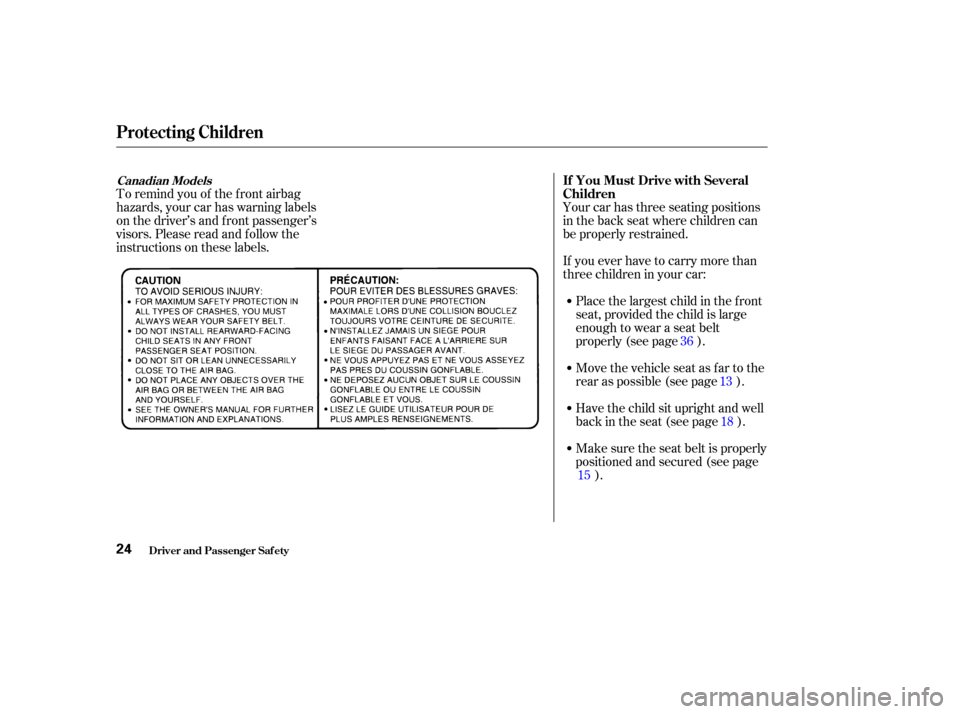
To remind you of the f ront airbag
hazards, your car has warning labels
on the driver’s and f ront passenger’s
visors. Please read and f ollow the
instructions on these labels.Your car has three seating positions
in the back seat where children can
be properly restrained.
If you ever have to carry more than
three children in your car:
Place the largest child in the f ront
seat, provided the child is large
enough to wear a seat belt
properly (see page ).
Have the child sit upright and well
backintheseat(seepage ).
Make sure the seat belt is properly
positioned and secured (see page ).
Move the vehicle seat as far to the
rear as possible (see page ).
36
1318
15
Protecting Children
Driver and Passenger Saf ety
If You Must Drive with Several
ChildrenCanadian Models
24
Page 30 of 364
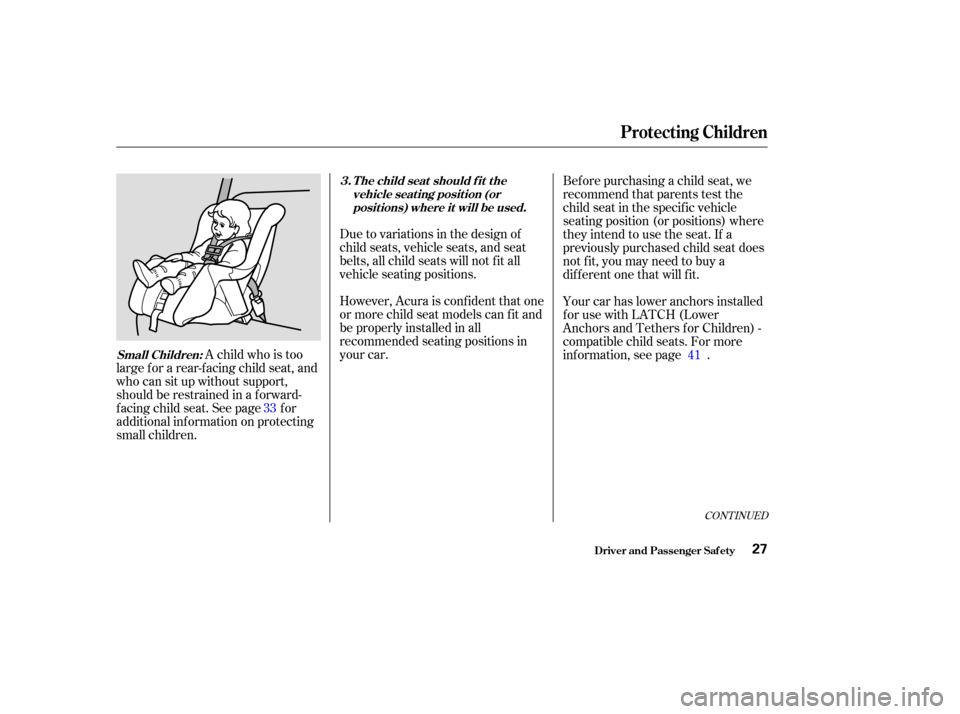
A child who is too
large f or a rear-f acing child seat, and
who can sit up without support,
should be restrained in a f orward-
f acing child seat. See page f or
additional inf ormation on protecting
small children. Due to variations in the design of
child seats, vehicle seats, and seat
belts, all child seats will not f it all
vehicle seating positions.
However, Acura is conf ident that one
or more child seat models can f it and
be properly installed in all
recommended seating positions in
your car.
Bef ore purchasing a child seat, we
recommend that parents test the
child seat in the specif ic vehicle
seating position (or positions) where
they intend to use the seat. If a
previously purchased child seat does
not f it, you may need to buy a
dif f erent one that will f it.
Your car has lower anchors installed
for use with LATCH (Lower
AnchorsandTethersforChildren)-
compatible child seats. For more
inf ormation, see page .
33 41
CONT INUED
Small Children:T he child seat should f it the
vehicle seat ing posit ion (orposit ions) where it will be used.
3.
Protecting Children
Driver and Passenger Saf ety27
Page 31 of 364
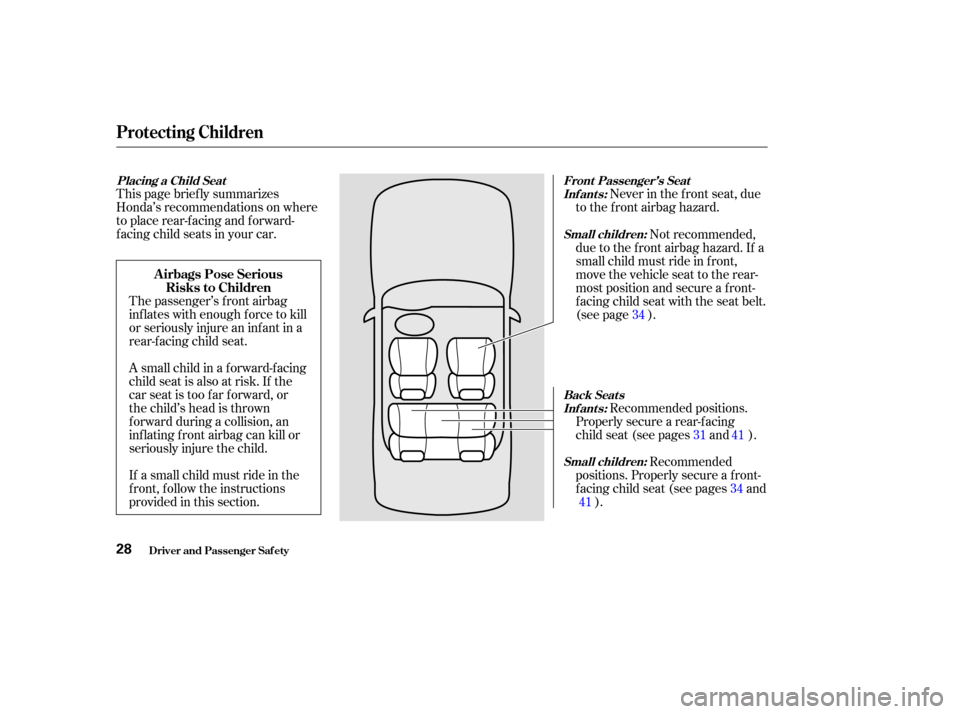
This page brief ly summarizes
Honda’s recommendations on where
to place rear-facing and forward-
f acing child seats in your car.Never in the f ront seat, due
to the f ront airbag hazard.
The passenger’s f ront airbag
inf lates with enough f orce to kill
or seriously injure an inf ant in a
rear-facing child seat.
If a small child must ride in the
f ront, f ollow the instructions
provided in this section. A small child in a f orward-f acing
child seat is also at risk. If the
carseatistoofarforward,or
the child’s head is thrown
f orward during a collision, an
inf lating f ront airbag can kill or
seriously injure the child. Recommended
positions. Properly secure a f ront-
f acing child seat (see pages and ).Recommended positions.
Properlysecurearear-facing
child seat (see pages and ). Not recommended,
due to the f ront airbag hazard. If a
small child must ride in f ront,
move the vehicle seat to the rear-
most position and secure a f ront-
facing child seat with the seat belt.
(see page ). 34
31 4134
41
Placing a Child Seat Front Passenger’s Seat
Inf ant s:
Back Seat sSmall children:
Inf ant s:
Small children:
Airbags Pose Serious
Risks to Children
Protecting Children
Driver and Passenger Saf ety28
Page 32 of 364
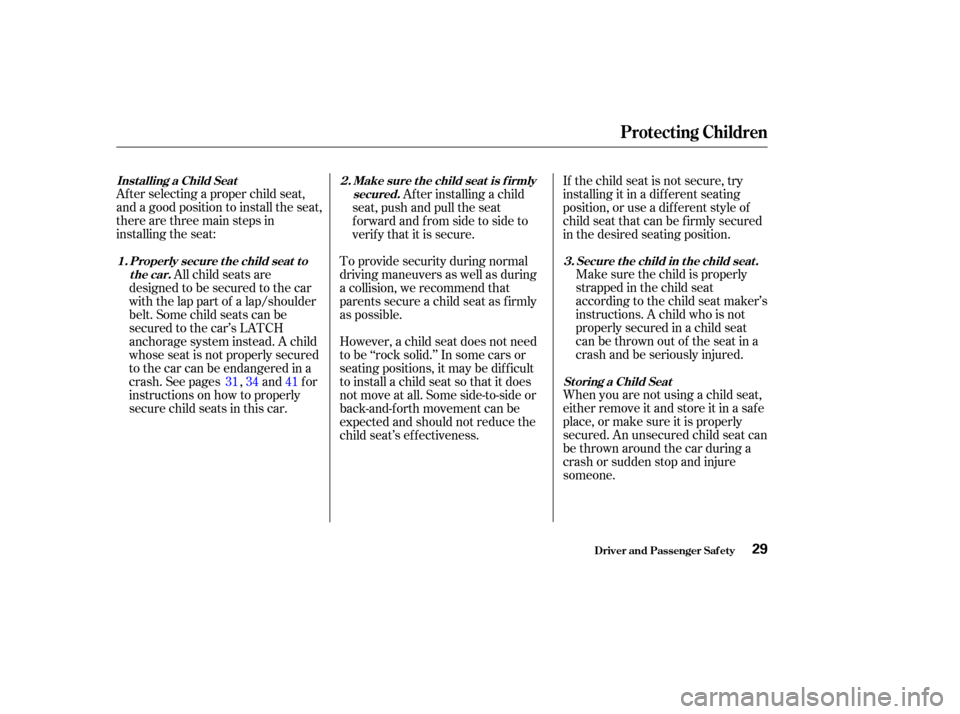
Af ter selecting a proper child seat,
and a good position to install the seat,
there are three main steps in
installing the seat:When you are not using a child seat,
either remove it and store it in a saf e
place, or make sure it is properly
secured. An unsecured child seat can
be thrown around the car during a
crash or sudden stop and injure
someone.Make sure the child is properly
strappedinthechildseat
according to the child seat maker’s
instructions. A child who is not
properly secured in a child seat
canbethrownoutof theseatina
crash and be seriously injured.
If the child seat is not secure, try
installing it in a dif f erent seating
position, or use a dif f erent style of
child seat that can be f irmly secured
in the desired seating position.
To provide security during normal
driving maneuvers as well as during
a collision, we recommend that
parents secure a child seat as f irmly
as possible. Af ter installing a child
seat, push and pull the seat
f orward and f rom side to side to
verif y that it is secure.
All child seats are
designed to be secured to the car
with the lap part of a lap/shoulder
belt. Some child seats can be
secured to the car’s LATCH
anchorage system instead. A child
whose seat is not properly secured
to the car can be endangered in a
crash. See pages , and for
instructions on how to properly
secure child seats in this car. However, a child seat does not need
to be ‘‘rock solid.’’ In some cars or
seating positions, it may be dif f icult
to install a child seat so that it does
not move at all. Some side-to-side or
back-and-f orth movement can be
expected and should not reduce the
child seat’s ef f ectiveness.
31 34 41
Inst alling a Child Seat
Storing a Child Seat
Secure the child in the child seat.
Make sure t he child seat is f irmly
secured.
Properly secure t he child seat t o the car.
1. 2.
3.
Protecting Children
Driver and Passenger Saf ety29
Page 34 of 364
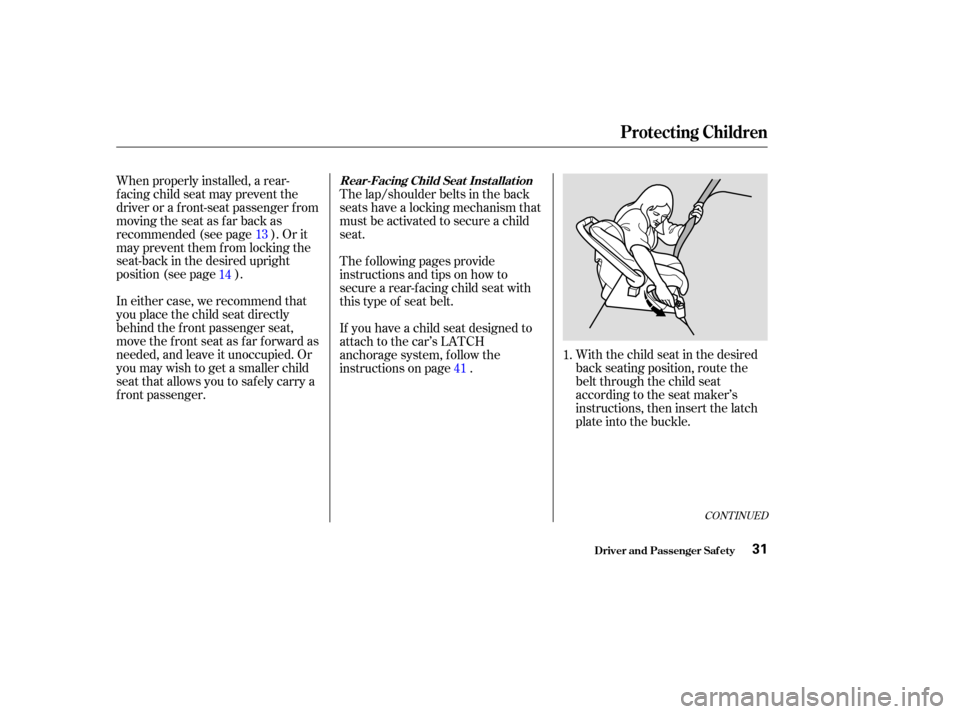
With the child seat in the desired
back seating position, route the
belt through the child seat
according to the seat maker’s
instructions, then insert the latch
plate into the buckle.
When properly installed, a rear-
f acing child seat may prevent the
driver or a f ront-seat passenger f rom
moving the seat as far back as
recommended (see page ). Or it
may prevent them f rom locking the
seat-back in the desired upright
position (see page ).
In either case, we recommend that
you place the child seat directly
behind the f ront passenger seat,
move the front seat as far forward as
needed, and leave it unoccupied. Or
you may wish to get a smaller child
seat that allows you to safely carry a
f ront passenger.
The lap/shoulder belts in the back
seats have a locking mechanism that
must be activated to secure a child
seat.
The f ollowing pages provide
instructions and tips on how to
secure a rear-f acing child seat with
this type of seat belt.
If you have a child seat designed to
attach to the car’s LATCH
anchorage system, follow the
instructions on page .
1.
13
14
41
CONT INUED
Protecting Children
Driver and Passenger Saf ety
Rear-Facing Child Seat Inst allat ion
31
Page 35 of 364
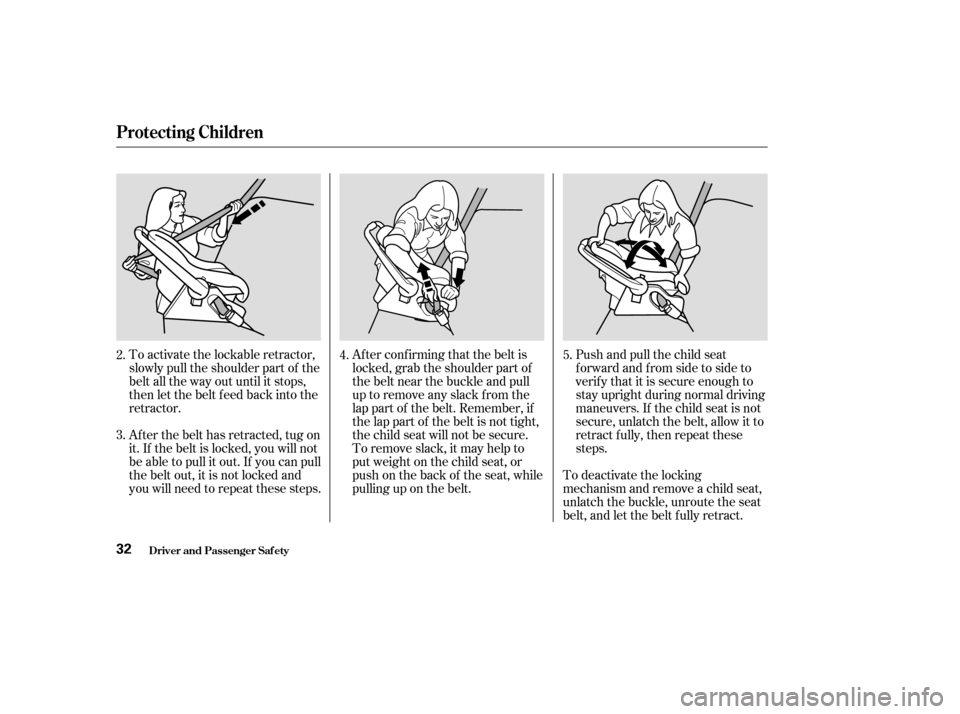
Af ter conf irming that the belt is
locked, grab the shoulder part of
the belt near the buckle and pull
up to remove any slack from the
lap part of the belt. Remember, if
the lap part of the belt is not tight,
the child seat will not be secure.
To remove slack, it may help to
putweightonthechildseat,or
push on the back of the seat, while
pulling up on the belt.Push and pull the child seat
f orward and f rom side to side to
verif y that it is secure enough to
stay upright during normal driving
maneuvers. If the child seat is not
secure, unlatch the belt, allow it to
retract f ully, then repeat these
steps.
To deactivate the locking
mechanism and remove a child seat,
unlatch the buckle, unroute the seat
belt, and let the belt f ully retract.
To activate the lockable retractor,
slowly pull the shoulder part of the
belt all the way out until it stops,
then let the belt f eed back into the
retractor.
Af ter the belt has retracted, tug on
it. If the belt is locked, you will not
be able to pull it out. If you can pull
the belt out, it is not locked and
you will need to repeat these steps.
2.
3.
4.
5.
Protecting Children
Driver and Passenger Saf ety32
Page 37 of 364
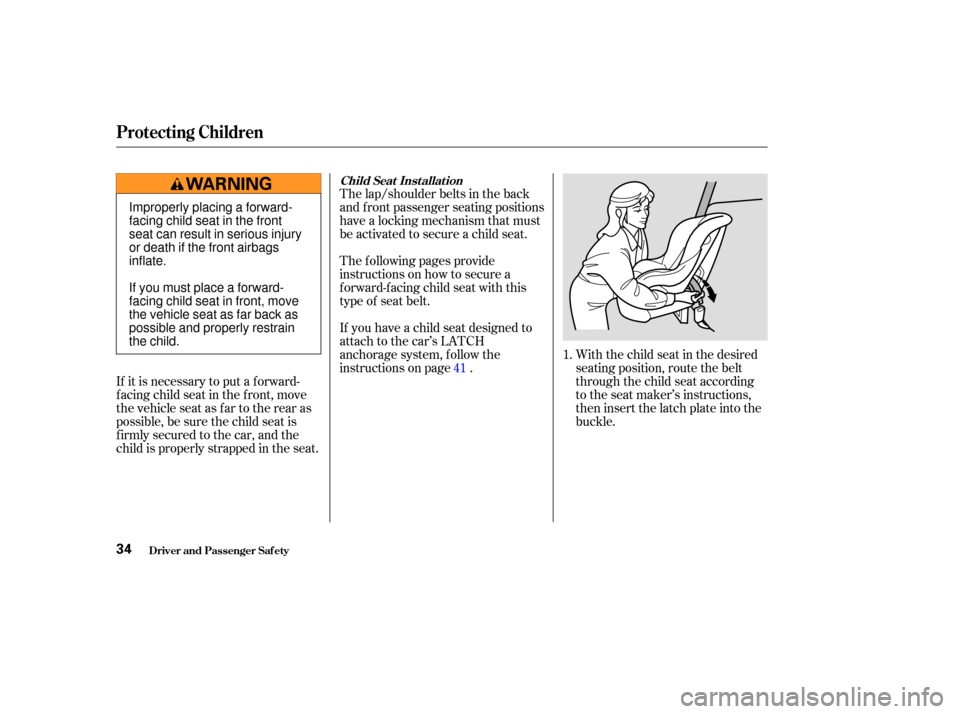
The lap/shoulder belts in the back
and f ront passenger seating positions
have a locking mechanism that must
be activated to secure a child seat.With the child seat in the desired
seating position, route the belt
through the child seat according
to the seat maker’s instructions,
then insert the latch plate into the
buckle.
The f ollowing pages provide
instructions on how to secure a
f orward-f acing child seat with this
type of seat belt.
If you have a child seat designed to
attach to the car’s LATCH
anchorage system, follow the
instructions on page .
If it is necessary to put a f orward-
f acing child seat in the f ront, move
the vehicle seat as far to the rear as
possible, be sure the child seat is
f irmly secured to the car, and the
child is properly strapped in the seat. 1.
41
Child Seat Inst allat ion
Protecting Children
Driver and Passenger Saf ety34
Improperly placing a forward-
facing child seat in the front
seat can result in serious injury
or death if the front airbags
inflate.
Ifyoumustplaceaforward-
facing child seat in front, move
the vehicle seat as far back as
possible and properly restrain
the child.
Page 38 of 364
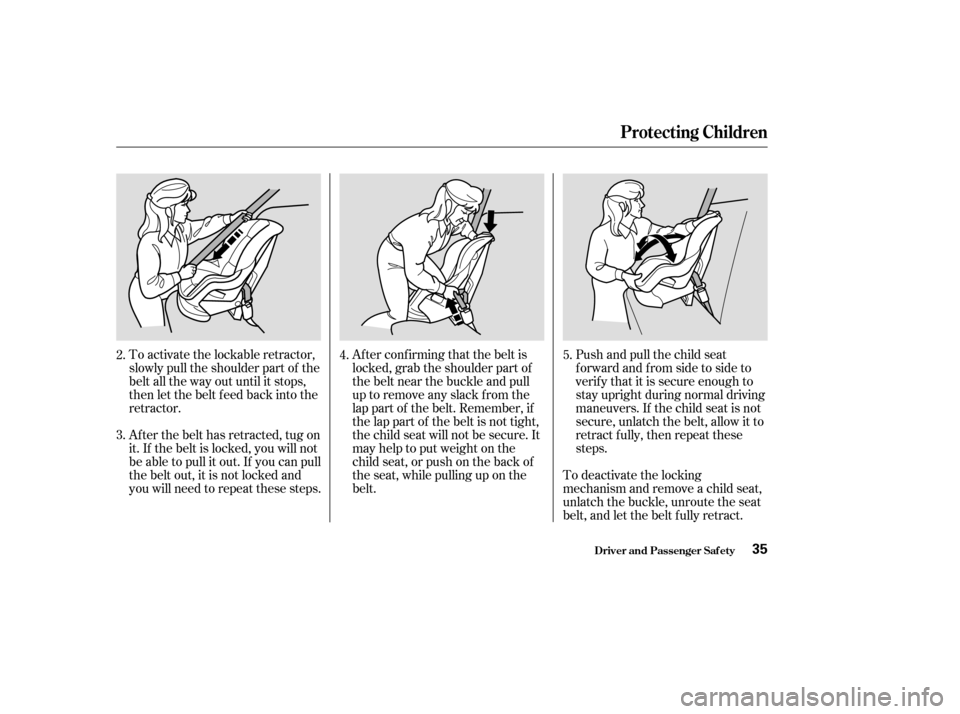
Af ter conf irming that the belt is
locked, grab the shoulder part of
the belt near the buckle and pull
up to remove any slack from the
lap part of the belt. Remember, if
the lap part of the belt is not tight,
the child seat will not be secure. It
mayhelptoputweightonthe
child seat, or push on the back of
the seat, while pulling up on the
belt.Push and pull the child seat
f orward and f rom side to side to
verif y that it is secure enough to
stay upright during normal driving
maneuvers. If the child seat is not
secure, unlatch the belt, allow it to
retract f ully, then repeat these
steps.
To deactivate the locking
mechanism and remove a child seat,
unlatch the buckle, unroute the seat
belt, and let the belt f ully retract.
To activate the lockable retractor,
slowly pull the shoulder part of the
belt all the way out until it stops,
then let the belt f eed back into the
retractor.
Af ter the belt has retracted, tug on
it. If the belt is locked, you will not
be able to pull it out. If you can pull
the belt out, it is not locked and
you will need to repeat these steps.
2.
3.
4.
5.
Protecting Children
Driver and Passenger Saf ety35
Page 39 of 364
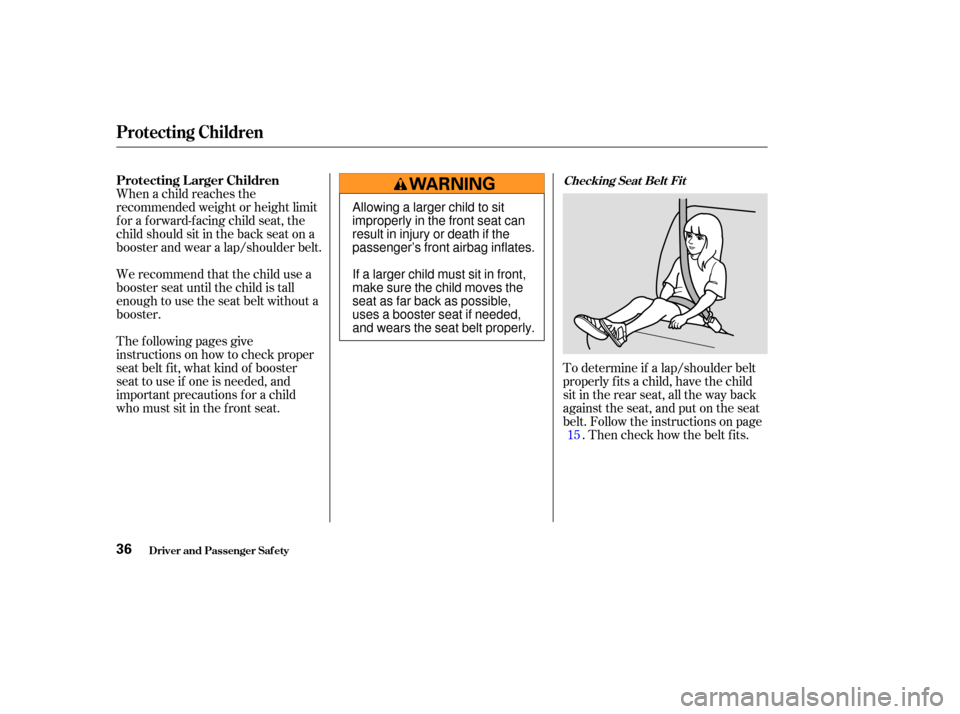
When a child reaches the
recommended weight or height limit
for a forward-facing child seat, the
child should sit in the back seat on a
booster and wear a lap/shoulder belt.
We recommend that the child use a
booster seat until the child is tall
enough to use the seat belt without a
booster.
The f ollowing pages give
instructions on how to check proper
seat belt f it, what kind of booster
seat to use if one is needed, and
important precautions f or a child
who must sit in the f ront seat.To determine if a lap/shoulder belt
properly f its a child, have the child
sit in the rear seat, all the way back
against the seat, and put on the seat
belt. Follow the instructions on page
. Then check how the belt f its.
15
Checking Seat Belt Fit
Protecting Children
Driver and Passenger Saf ety
Protecting L arger Children
36
Allowing a larger child to sit
improperly in the front seat can
result in injury or death if the
passenger’s front airbag inflates.
If a larger child must sit in front,
make sure the child moves the
seat as far back as possible,
uses a booster seat if needed,
and wears the seat belt properly.
Page 40 of 364
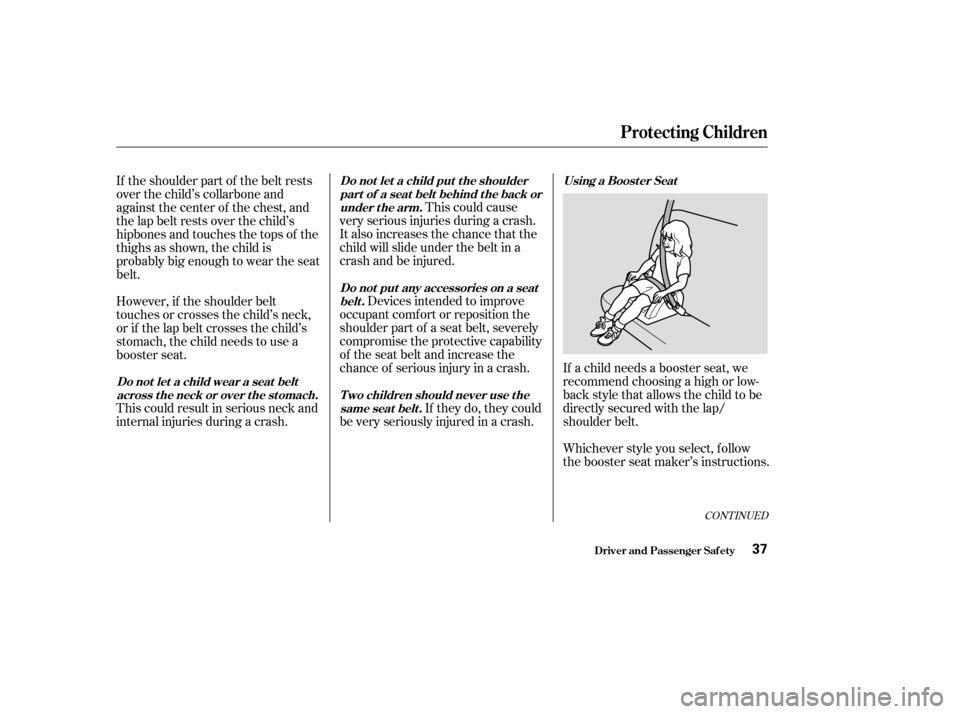
CONT INUED
Whichever style you select, f ollow
the booster seat maker’s instructions.
This could cause
very serious injuries during a crash.
It also increases the chance that the
child will slide under the belt in a
crash and be injured.
Devices intended to improve
occupant comf ort or reposition the
shoulder part of a seat belt, severely
compromise the protective capability
of the seat belt and increase the
chance of serious injury in a crash.
If they do, they could
be very seriously injured in a crash. If a child needs a booster seat, we
recommend choosing a high or low-
back style that allows the child to be
directly secured with the lap/
shoulder belt.
If the shoulder part of the belt rests
over the child’s collarbone and
against the center of the chest, and
the lap belt rests over the child’s
hipbones and touches the tops of the
thighs as shown, the child is
probably big enough to wear the seat
belt.
However, if the shoulder belt
touchesorcrossesthechild’sneck,
or if the lap belt crosses the child’s
stomach, the child needs to use a
booster seat.
This could result in serious neck and
internal injuries during a crash.
Protecting Children
Driver and Passenger Saf ety
Using a Boost er Seat
Do not let a child put the shoulder
part of a seat belt behind t he back orunder t he arm.
Do not put any accessories on a seatbelt.
T wo children should never use t hesame seat belt .
Do not let a child wear a seat belt
across t he neck or over t he st omach.
37